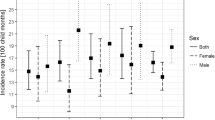Abstract
Objective
To estimate the incidence of unintentional childhood injuries and to assess the impact of injury during childhood.
Methods
This is a cross sectional study, conducted in 13 clusters of a rural block in Vellore. Children were screened by two-stage cluster sampling method by two weeks and three months recall method. The primary caregivers of injured children were administered a questionnaire to assess the impact of the injury.
Results
Childhood injury related morbidity was 292.5 per 1000 y. Children between 10 and 14 y (4.6%) and boys (4.5%) had a higher rate of injury. Fall (43.1 %) was the most common cause of injury followed by RTIs (Road Traffic Incidents- 27.6%). Work absenteeism for primary caregivers ranged from 1 to 60 (IQR 2–7) days. Sickness absenteeism ranged from 1 to 45 d with a mean of 7.64 (IQR 2–7) days. Half of the children missed school after an injury. The days spent with temporary disability ranged from 1 to 60 d with a mean of 11.79 (IQR 2–7) d and 7.73% had permanent disability.
Conclusions
Unintentional childhood injury is a neglected public health problem which leads to sickness absenteeism and disability. Boys and older children are the most common victims of injury. There is a need for establishing state or nationwide injury registries to help understand accurate estimates of disability-adjusted life year (DALY) and loss of productivity.
Similar content being viewed by others
References
Peden M, Oyegbite K, Ozanne-Smith J, World Report on Child Injury prevention World Health Organization [Internet];2008. Available at: http://whqlibdoc.who.int/publications/2008/9789241563574_eng.pdf. Accessed on 21 Oct 2013.
Patton GC, Coffey C, Sawyer SM, et al. Global patterns of mortality in young people: a systematic analysis of population health data. Lancet. 2009;374:881–92.
Million Death Study Collaborators, Bassani DG. Kumar R, Awasthi S, et al. Causes of neonatal and child mortality in India: a nationally representative mortality survey. Lancet. 2010;376:1853–60.
Mahalakshmy T, Dongre AR, Kalaiselvan G. Epidemiology of childhood injuries in rural Puduchery. Indian J Pediatr. 2011;78:821–5.
Rivara FP, Calonge N, Thompson RS. Population based study of unintentional injury and impact on childhood. Am J Public Health. 1989;79:990–4.
Gofin R, Adler B, Hass T. Incidence and impact of childhood and adolescent injuries: a population- based study. J Trauma. 1999;47:15–21.
Sivamani M, Balraj V, Muliyil J. Validity of a surveillance system for childhood injuries in a rural block of Tamil Nadu. Indian J Community Med. 2009;34:43–7.
Report to UNICEF on Vietnam Multicentre injury survey [internet]. 2003. Available at: http://www.tasc-gcipf.org/downloads/Vietnam%20-%20 UNICEFfinalVMISreportfinal.pdf. Accessed on 31 Oct 2013.
Moshiro C, Heuch I, Åstrøm AN, Setel P, Kvåle G. Effect of recall in estimation of non-fatal injury rates: a community based study in Tanzania. Inj Prev. 2005;11:48–52.
Nirgude AS, Naik PR, Sheikh N. Study pattern of childhood injuries in a rural area of South India. Indian J Forensic Med Toxicol. 2010;8:62–7.
Gordon JE, Gulati PV, Wyon JB. Traumatic accidents in rural tropical regions: an epidemiological field study in Punjab. India Am J Med Sci. 1962;243:382–402.
Safe Kids Canada. Child & Youth Unintentional Injury: 10 Years in Review 1994–2003 [internet]. 2006. Available at: http://www.mhp.gov.on.ca/en/ prevention/injury-prevention/skc_injuries.pdf. Accessed on 23 Nov 2015.
Rebecca F, Antony F. Reducing unintentional injuries in childhood: a research review, NCB research Centre [internet]. 2010. Available at: http://www.ncb.org.uk/media/432942/childhood_unintentional_injuries_review.pdf. Accessed on 23 Nov 2015.
Fatmi Z, Kazi A, Hadden WC, Bhutta ZA, Razzak JA, Pappas G. Incidence and pattern of unintentional injuries and resulting disability among children under 5 years of age: results of the National Health Survey of Pakistan. Paediatr Perinat Epidemiol. 2009;23:229–38.
Arif AA, Patterson PJ, Borders TF, Shah SM. The epidemiology of unintentional nonfatal injuries among children in the south plains/panhandle region of Texas. Texas J Rural Health. 2003;21:31–41.
Zaidi SHN, Khan Z, Khalique N. Injury pattern in children: a population based study. Indian J Comm Health. 2013;25:45–51.
Gururaj G, Kolluri SVR, Chandramouli BA, Subbakrishna DK, Kraus JF; Traumatic Brain Injury. Bangalore, India: National Institute of Mental Health and Neurosciences, Publication No. 61; 2005.
Bryant B, Mayou R, Wiggs L, Ehlers A, Stores G. Psychological consequences of road traffic accidents for children and their mothers. Psychol Med. 2004;34:335–46.
Kreisfeld R, Henley G. Deaths and hospitalizations due to drowning, Australia 1999–2000 to 2003–2004. Adelaide [internet] 2008. Available at: http://www.aihw.gov.au/publication-detail/?id=6442468078. Accessed on 23 Nov 2015.
Susiva C, Boonrong T. Near-drowning in pediatric respiratory intensive care unit, Siriraj Hospital. J Med Assoc Thailand. 2005;88:S44–7.
Mashreky SR, Rahman A, Chowdhury SM, et al. Epidemiology of childhood burn: yield of largest community based injury survey in Bangladesh. Burns. 2008;34:856–62.
Contributions
LRI: Concepts, design, definition of intellectual content, literature search, experimental studies, data acquisition and analysis, statistical analysis, manuscript preparation and review; AR and AB: Concepts, design, definition of intellectual content, literature search, experimental studies, manuscript review; KG: Concepts, design, definition of intellectual content, literature search, experimental studies, statistical analysis, manuscript review. KG will act as guarantor for the paper.
Author information
Authors and Affiliations
Corresponding author
Ethics declarations
Ethical Approval
All procedures performed in studies involving human participants were in accordance with the ethical standards of the institutional research committee and with the 1964 Helsinki declaration and its later amendments or comparable ethical standards.
Informed Consent
Informed consent was obtained from all the individual participants included in the study.
Conflict of Interest
None.
Source of Funding
Fluid Research Fund, Christian Medical College, Vellore, Tamil Nadu, India.
Rights and permissions
About this article
Cite this article
Inbaraj, L.R., Rose, A., George, K. et al. Incidence and Impact of Unintentional Childhood Injuries: A Community Based Study in Rural South India. Indian J Pediatr 84, 206–210 (2017). https://doi.org/10.1007/s12098-016-2260-6
Received:
Accepted:
Published:
Issue Date:
DOI: https://doi.org/10.1007/s12098-016-2260-6



